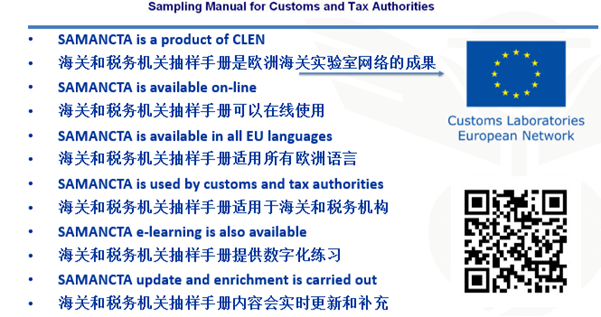Activities carried out under Action 3
| Activities | Objectives |
| Project Group on Compliance assessment, use of precision data and statistics | Enrichment and revision of the guidelines on “measurement uncertainty and decision rules in compliance assessment” |
| Project Group on Sampling | Development and maintenance of Samancta, the Sampling Manual for Customs and Tax Authorities |
| CLEN Triennial survey | One of the tools used to enhance mutual knowledge of EU customs laboratories, by providing a detailed administrative and scientific portrait of the laboratories. The last survey was conducted in 2022 to collect laboratories’ 2021 data. |
Project Group on Compliance assessment
Although quality requirements are the same for all Member States’ customs laboratories, their implementation may vary because of specific quality system. The aim is therefore to work towards the development of guidelines, with the use of statistics for processing precision data and other performance characteristics obtained in proficiency tests, to help interpreting analytical results for all customs laboratories. This ensures uniform interpretation of new standards and mutual acceptability of test data without the need for further re-testing of products.
The increasing number of methods of analysis accredited according to ISO 17025 (i.e., an international standard guaranteeing laboratories’ competence of testing) clearly shows the constant effort made by customs laboratories to improve their skills and ensure quality of testing.
Project Group on Sampling
- A guide to the sampling of goods for customs and tax inspection
Samancta is a sampling manual in the shape of an Internet application, providing a consistent set of sampling instructions for officers in all Member States and beyond. It is available in 23 European languages and freely accessible online.
Access to the sampling manual Samancta here.
The aim of Samancta is:
- to improve the quality of samples received for analysis at laboratories,
- to harmonise procedures across Member States, and
- to provide constructive guidance to officers on the sampling methods to be used for each type of product.
Samancta is organised by chapters and sampling procedure cards:
| General Chapters | Sampling procedure cards |
|
|
Samancta is also used for training purposes:
| Samancta trainings | Presentation of Samancta to the Customs Authorities and practical training on sampling of various goods:
|
| Samancta workshop | Presentation of Samancta to the Customs Authorities:
|
An eLearning course providing guidance on how to use Samancta has been developed by the European Commission, with support of a project team of national experts under the Customs 2020 Programme. This course is aimed for Member States’ customs and tax authorities and explains in detail how to navigate through Samancta and its sampling procedures. It is currently available in 13 languages.
More information and access to the course here.

